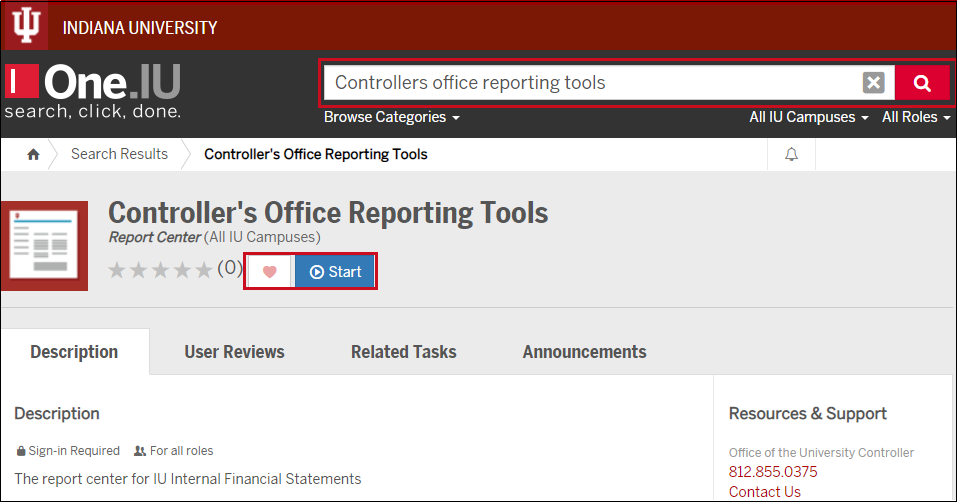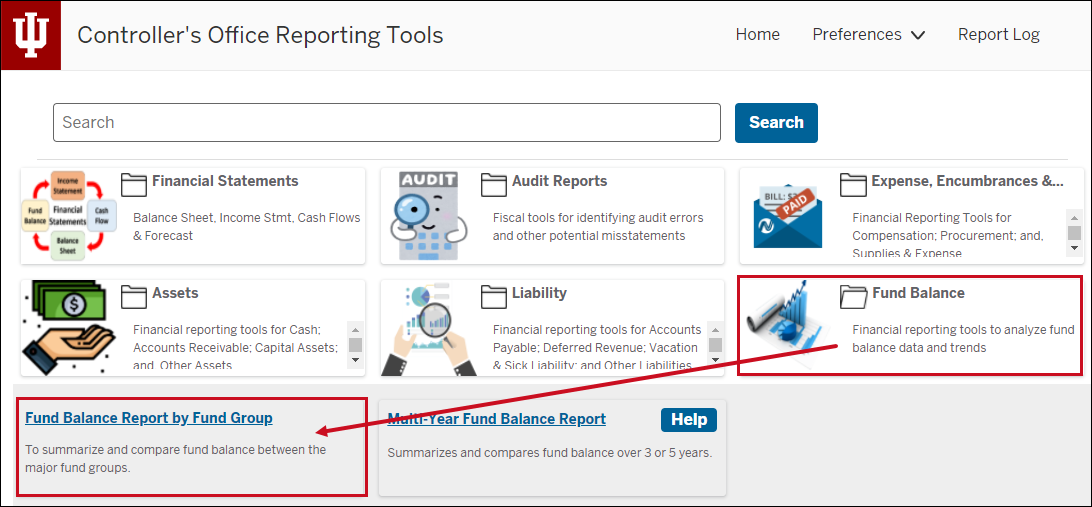Prerequisites
Prior to reading the instructions on the Fund Balance by Fund Group Report, it is beneficial to review the following sections of the IU Accounting Standards Book to gain foundational information along with report requirements and best practices:
- Accounting Fundamentals Pressbook
- Chart of Accounts and General Ledger Pressbook
- Financial Statements Pressbook
Overview
The Fund Balance by Fund Group Report was introduced to help monitor, analyze and compare fund balance across all fund groups at Indiana University. The report is designed to allow comparative measurement and identification of fund balances at the department, responsibility center, and campus levels as well as to the consolidated university level on a fiscal year basis. If not managed properly, a unit’s fund balance can shrink or even end up in the negative. A low or negative fund balance can be an indicator that a unit is in financial turmoil. For more information on what makes up the fund balance from an accounting perspective, see the Balance Sheet standard in the accounting standards book
How the Fund Balance by Fund Group Report Works
The Fund Balance by Fund Group Report is designed to show comparative fund balances for a desired fiscal year thru a specified fiscal period. Users also have the option to include the prior year fund balances for year over year comparison.
Each column on the report represents an individual fund group. If specific fund group(s) are provided as a parameter, only the specified fund group(s) will be displayed. Otherwise, all fund groups will be displayed.
The Fund Balance by Fund Group Report is made up of several essential transactions. It is important that users understand what each of these transactions represents. A brief description of what is included in each report line item is provided below:
- Fund Balance – This represents the opening balance as of July 1 pulled directly from the balance sheet for the periods selected.
- Operating Margin – This represents operating revenues less any operating expenses and is pulled directly from the income statement for the periods selected.
- Non-Operating Revenues – This represents revenues that have been incurred outside of the entity’s day-to-day activity and is pulled directly from the income statement for the periods selected.
- Non-Operating Expenses - This represents expenses that have been incurred outside of the entity’s day-to-day activity and is pulled directly from the income statement for the periods selected.
Note: If parameter ‘Sum Non-Operating Revenues/Expenses?’ is checked, Non-Operating Revenues and Expenses lines will be summed and displayed in the report as Non-Operating Margin.
- Net Transfer Income (Expense) – This represents the net of transfer income and expense incurred for the period, pulled directly from the income statement for the periods selected. This line item will only display in the report when the parameter ‘Exclude Transfers from Operating and Non-Operating Margins (Required for UCO closing materials)’ is checked.
- Net Capital Purchased and FB Offset – Due to the organizational structure of fund groups within IU, the offsetting entries used to make capital purchases are not recorded within the same fund group (typically the sale is recorded in a general or designated fund and the asset is recorded in the plant fund). This line represent the mismatch between the two fund groups to correctly record the entire purchase within one fund.
- Direct Hits to 9899 on JV Document – This is an entry done internally by UCO using a journal voucher (JV) document. Typically, these entries are done at the campus level.
- Direct Transfers to 9899 on Asset Transfer Document – This is an entry done internally by UCO using an asset transfer (AT) document. Typically, these entries are done at the campus level.
The Fund Balance by Fund Group Report can be located at the top of this page - refer to the top right blue button labeled "Go to Report" which will automatically redirect users to the report within the Controller's Office Reporting Tools.
In addition, the report can be found in One.IU. To find the report, search for “Controller’s Office Reporting Tools” in the search bar, and select Controller’s Office Reporting Tools (Report Center) in the drop down menu. Mark this task as a favorite by clicking the heart icon next to the start button and then select Start or click on title.

Once in the Controller’s Office Reporting Tools, users will see all available reporting tiles. Navigate to the Fund Balance folder. A new tile opens, which displays all the available fund balance reports. Select the Fund Balance by Fund Group Report.

Running the Report
Define the search parameters to return results relevant to your organization or to a specific account. The search parameters available in the Fund Balance by Fund Group Report are divided into three parameter types: chart of account report parameters, report specific parameters and display parameters.
If there are questions related to running the report, requirements or reviewing results, please contact your (RC) fiscal officer or campus office. Each campus may have individual specific requirements related to the report. Be sure to reach out to the related campus office or fiscal officer prior to quarter closings.
General Notes: Do not include any special characters other than approved wildcards in any of the below parameters. Additionally, do not run reports by campus as it will take up valuable computing services.
A number of parameters are available to aid users in tailoring their report data. At this time, University Fiscal Year and Thru University Fiscal Period Code are required parameters. All other parameters are optional. Keep in mind that the broader your search parameters, the longer the report will take to run.
Several of the parameters have a valid values function which displays the available codes and corresponding descriptions.
| Parameter | Description |
|---|---|
| University Fiscal Year | Used to limit report to a specific fiscal year(s). |
| University Fiscal Period Code | Used to limit report to a specific fiscal period(s). |
| Chart Code | Used to limit report to one or more specific chart of accounts. For assistance determining your chart code, refer to KFS Chart Lookup. |
| Campus | Used to limit report to a specific campus. |
| Responsibility Center Code | Used to limit to a specific RC. Users are encouraged to use this parameter in conjunction with a chart of accounts code. For assistance determining your RC code, refer to KFS RC Lookup. |
| Organization Code | Used to limit report to a specific organization code. Users are encouraged to use this parameter in conjunction with a chart code. |
| Account Number | Used to limit report to one or more specific account(s). |
| Sub-Account Number | Used to limit report to one or more specific sub-accounts. |
| Fund Group Code | Used to limit report to specific fund group(s). |
| Sub-Fund Group Code | Used to limit report to specific sub-fund group(s). |
| Include Organization Hierarchy | Check/Uncheck – By selecting the organization hierarchy, users will be able to see all data from the selected organization plus any organizations that report to the selected organization. |
A report specific parameter is a parameter that is limited to a single or small group of reports.
| Parameter | Description |
|---|---|
| Exclude 01* Accounts | Check/Uncheck - if checked, excludes all accounts with leading digits “01” from report. |
| Exclude Campus Consolidation Accounts | Check/Uncheck - if checked, excludes all campus consolidation accounts from report. |
| Sum Non-Operating Revenues/Expenses | Check to net Non-Operating Revenues and Non-Operating Expenses. This will be displayed as Non-Operating Margin in the report. Uncheck to show Non-Operating Revenues and Non-Operating Expenses as separate line items. |
Display parameters are parameters that define and restrict the visual presentation of the Multi-Year Cash Balance by Fund Group report. They are found on the lower part of the parameters.
| Parameter | Description |
|---|---|
| Include Prior Year | Check/Uncheck - If the user checks the "include prior year", then the prior year fund balances will be displayed in the report output. |
| Show Zero Balances | Shows fund balance transaction lines that have been used in the past but have had zero balances in the specific years the user has selected. |
| Include Closed Accounts | Check/Uncheck – includes the accounts closed during and in prior periods. Users are encouraged to check this box especially for comparative periods. |
| Exclude Transfers from Operating and Non-Operating Margins (Required for UCO closing materials) | Check/Uncheck – transfer object codes are pulled from above the Net Income line and presented below Net Income to aid in financial decision-making. |
| Select the Output Format | Automatically selected as Excel. |
| Select the Output Destination | The user has the option to choose where they want their report to go once it is ready. The user can either Wait for it to pop up on the screen or have it sent to their Email. If the user selects email output destination, an email will be sent with the link to you selected output format. |
Click Save Parameter Settings to save your parameters for future use of this report. For instructions on how to save settings, review the Save Parameter Settings document on the Controller’s Office Reporting Tools page.